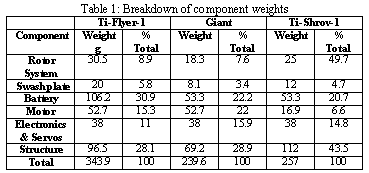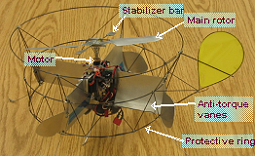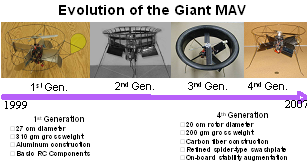Single Rotor System with Turning Vanes
[Jayant Sirohi, Marat Tishckenko, Vikram Harishkeshavan]
A compact, lightweight MAV is being developed by installing vanes in the downwash of a single main rotor to counteract its torque. This may help to obtain a good hovering efficiency. The goal is to design a vehicle with a level of inherent flight stability so that electronics requirement to stabilize it under different flight conditions becomes minimum. The first prototype vehicle was built with a 2-bladed rotor of diameter 25 cm with a negative pitch-flap ( ) coupling. Cyclic control was achieved through a swashplate introducing pitch motion to the Bell/Hiller servo-paddle that also helps to increase flight stability of the vehicle. A brushless DC motor was chosen as the propulsion system for the rotor. Three servo-actuators were chosen to actuate the longitudinal and lateral cyclic controls as well as the yaw control surfaces. A receiver, speed controller and yaw gyro constitute the other onboard electronics.
 The breakdown of components is given in Table-1. Protection to the rotor is provided by means of a ring framework that also acts as a support for the anti-torque vanes. In the second version, a duct was included to increase hover efficiency as well as to provide a higher degree of protection to the rotor. Four anti-torque vanes, each with a circular arc cross-section of 8% camber were attached to central body holding the DC motor. Systematic tests were performed in three configurations: rotor alone, rotor and vanes and rotor, vanes and duct. The baseline rotor was 15 cm diameter, 3-bladed fixed pitch with solidity of 0.15. The installing of the vanes resulted in an increase in power required by approximately 10% to produce a given level of thrust. This percentage increase in power is similar to that of typically required by a conventional tail rotor for a full-scale system. The combination of the ducted rotor increases the total thrust at a given electric power by approximately 25%. The addition of a duct has the further benefit that the net torque resulting from the combination of main rotor and the anti-torque vanes is constant and almost zero independent of the total thrust. However, the fabrication of the lightweight duct was found to be a challenging task.
The breakdown of components is given in Table-1. Protection to the rotor is provided by means of a ring framework that also acts as a support for the anti-torque vanes. In the second version, a duct was included to increase hover efficiency as well as to provide a higher degree of protection to the rotor. Four anti-torque vanes, each with a circular arc cross-section of 8% camber were attached to central body holding the DC motor. Systematic tests were performed in three configurations: rotor alone, rotor and vanes and rotor, vanes and duct. The baseline rotor was 15 cm diameter, 3-bladed fixed pitch with solidity of 0.15. The installing of the vanes resulted in an increase in power required by approximately 10% to produce a given level of thrust. This percentage increase in power is similar to that of typically required by a conventional tail rotor for a full-scale system. The combination of the ducted rotor increases the total thrust at a given electric power by approximately 25%. The addition of a duct has the further benefit that the net torque resulting from the combination of main rotor and the anti-torque vanes is constant and almost zero independent of the total thrust. However, the fabrication of the lightweight duct was found to be a challenging task.
Initially two prototype vehicles with a single main rotor and turning vanes were built. The first prototype TiFlyer-1 was constructed almost entirely out of aluminum sheet and has a total weight of 340 gm. The second prototype TiFlyer-2 was predominantly built out of carbon fiber and has a total weight of 240 gm. Both prototypes were test flown and demonstrated stable yaw characteristics. Recently, a third version of this vehicle was developed, called TiShrov-1 with gross weight of 257 gm and rotor diameter of 13.5 cm. A 55W brushless DC motor (8.6:1 gear ratio) was chosen and a high energy density (800mAH/50gms) LiPo battery was chosen as the source of power. A lightweight shroud was constructed out of carbon fiber strips and scotch tape. Since the tip clearance was found to be a key parameter in the performance of a shrouded rotor, it became necessary to maintain its minimum value to diffuse the tip vortex during the flight. As a result, it became difficult to enclose a 2-bladed teetering rotor in a shroud. This problem was resolved in TiShrove by incorporating a 2-bladed hingeless rotor (rigid hub). By suitably designing the rotor, Hiller-bar and phase angle, the performance of the rotor was improved. Two vane arrangements, X- and H-vanes, were examined for their anti-torque capability. Even though both type of vanes incurred about 10% loss in thrust for a given input of electric power, H-vanes resulted in significant reduction in its frontal area. This vehicle is being flight-tested.

